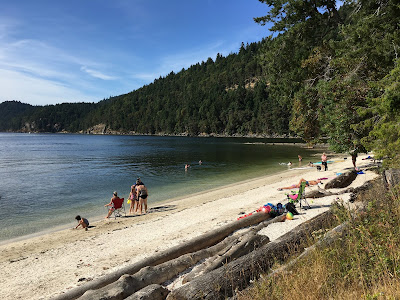
In three weeks spent driving 6200 miles around the western United States, this was the only noteworthy beach I could come up with. If it's a beach at all. We saw some other lakes (Flathead Lake Lake Monona, Lake Powell), but none generated any relevant beach pictures (Flathead and Monona have appeared in the blog previously). I guess we also drove through a lot of Paleozoic and Mesozoic sand dunes and possibly some beach deposits, but I lack both the geology and the pictures to tell a story.
The North Arm of the Great Salt Lake is isolated from the larger southern portion of the lake by a causeway - the result being this part of the lake lacks a significant freshwater source and is dropping and getting saltier every year. As it gets saltier, it fosters a complex community of algae and reddish purple bacteria that give the lake its unique tint.
AERIAL VIEW
The Spiral Jetty (Robert Smithson) was constructed at the water's edge in 1970 - an edge that must have been fairly persistent, as there is a fairly well defined cobble "beach" at the break in slope. It may be more a cobble lag - but I don't have much sense of the processes that were at work here.
During the 1980s and 1990s, the Jetty was submerged by higher lake levels, but has since reemerged. And the shoreline is now rapidly receding into the distance. The current "tide" flat is marked by salt encrusted ripples and sandbars. Where the small waves were breaking, froth was forming and blowing around.
The Spiral Jetty is art - not something one would pull a boat up to (even when water levels were higher). I won't say much more here, but there's some neat reading and some good videos online. I also posted about this spot on the other blog: hshipman: Spiral Jetty 2017.
Perhaps the most interesting beach story here is one I didn't get a chance to explore. Most of the hill slopes rising from the lake display remnants of ancient Lake Bonneville shorelines, including some fairly elaborate spits and related coastal landforms. They show up best in low sunlight and in aerial imagery.
































